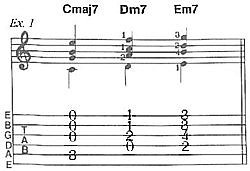Leo Kottke: Fingerstyle Visionary Learns From Tradition
by Mark Hanson
Page 3
Joe Pass teaches his students to visualize chords as they are playing scales --- for instance, visualizing a C chord on the 5th, 6th and 7th frets (and E sound) as they play an E major scale in that area of the neck. Do you do that?
No. I'm afraid that if I do that I'll wind up with a favorite. If I have set chords in mind, I'll be stuck with them. I'll have to lose them to come up with something new. I got stuck with the key of G when I was a beginning guitar player. I was there for years.
 |
I love the sound of major and minor sevenths, so I'm practicing harmonized scales, four notes at a time [Ex. 1]. That way I have the root, 3rd, 5th and 7th all happening together. I'm real interested in close harmonies, where the notes are close together in the voicings of the chords.
It seems that harmonized scales fit your solo style better than single-note lines do. Would you agree?
Yeah. I've always been one to play many strings at the same time. I haven't ever really practiced playing lead lines on top of another guitar part. But I want to be able to do that.
Judging from your most recent record, tone has become one of the most important aspects of your playing.
For me, tone is the whole thing. A lot of players just don't pay much attention to getting a good tone. But sooner or later you are bound to wake up to it. I've learned from people I've talked to in seminars that what kind of hand you are born with makes a big difference in the kind of tone you can produced. My thumb bends a lot, which has quite a bit to do with the bass sound that I get. I think the best thing for any player is to just be aware that tone exists, and to make the best one you can.
How have you gotten away form the alternating-bass patterns that are so prevalent in your earlier pieces?
That's been really hard, because a lot of it I will always like. I think I've avoided making it tiring -- to myself and the listeners -- by waving the thumb inside the melody. Although the thumb is taking its prescribed beat, it's part of the melody. When we started writing my music down [Leo Kottke -- Eight Songs, dist. by Hal Leonard Publishing], it was hard for me to decide which notes would have the stems aiming down [notes played by the thumb]. I don't hear it that way. I hear all six strings as one voice. If i have a choice when I'm writing, I try to give the thumb a rhythm other than a one-two-three-four. But then I'll come up with something where the thumb fits right into that rhythm without being boring or obtrusive. So I'm willing to use the steady bass beat with the thumb, if it works. I just try to make it a little more independent.
Much of the music on A Shout Toward Noon seems deliberately understated.
The first clue I got about restraint was when I realized that sometimes my tempos were pushing themselves. I'd start out with a rapid pace and I'd end up falling over myself. It's fun and it gets me off, but sometimes the tune suffers. So I tried developing a better sense of time, giving each notes its full value. That led to a wonderful sense of well- being about a tune -- it would really feel in place as I was playing. It allowed me to include a little more invention, a little more feel, a little more deliberation. I could make more happen.
What prompted you to record as much reflective material as you did on Shout?
That kind of material is what's happening currently in the marketplace, especially for guitar. But it's always been the case for me that I make a record with the material I have at hand. I've never been able to force that. I don't write to a commercial purpose. I write to feel good.
You are playing mostly 6-string now. What are the differences-- to you-- between a 6-string and a 12-string?
I used to think there were no differences. But once I gave up my fingerpicks, there was a definite difference. The 12-string has too many harmonics flying around to be able to go very far harmonically. And because of the high octave strings, sometimes you get melody notes in an octave you don't want. To me, the sound of a 12-string has to decay faster than the sound of a 6-string. It has to be more discreet. A good 12-string is one that sounds like a 6-string. The old Gibson B-45 that I had was that way. Until I can find another 12-string like that, I'm sold on the 6 string. [Ed. Note: Kottke's Gibson 12-string was stolen from his car in Portland, Oregon, after his first-ever performance with John Fahey.]
What was different about that Gibson?
It was very playable. The model I had was braced very lightly. But the production model B-45s fell apart when other people started using heavier strings on them. So the company beefed them up. I think that most guitars are built too heavy. Most 12-strings have so much weight in them that they sound like harpsichords, to my ears. So I'm having more fun with the 6-string right now. You can play in more detail on it. The dynamics are more apparent because there`s more room for it to show.